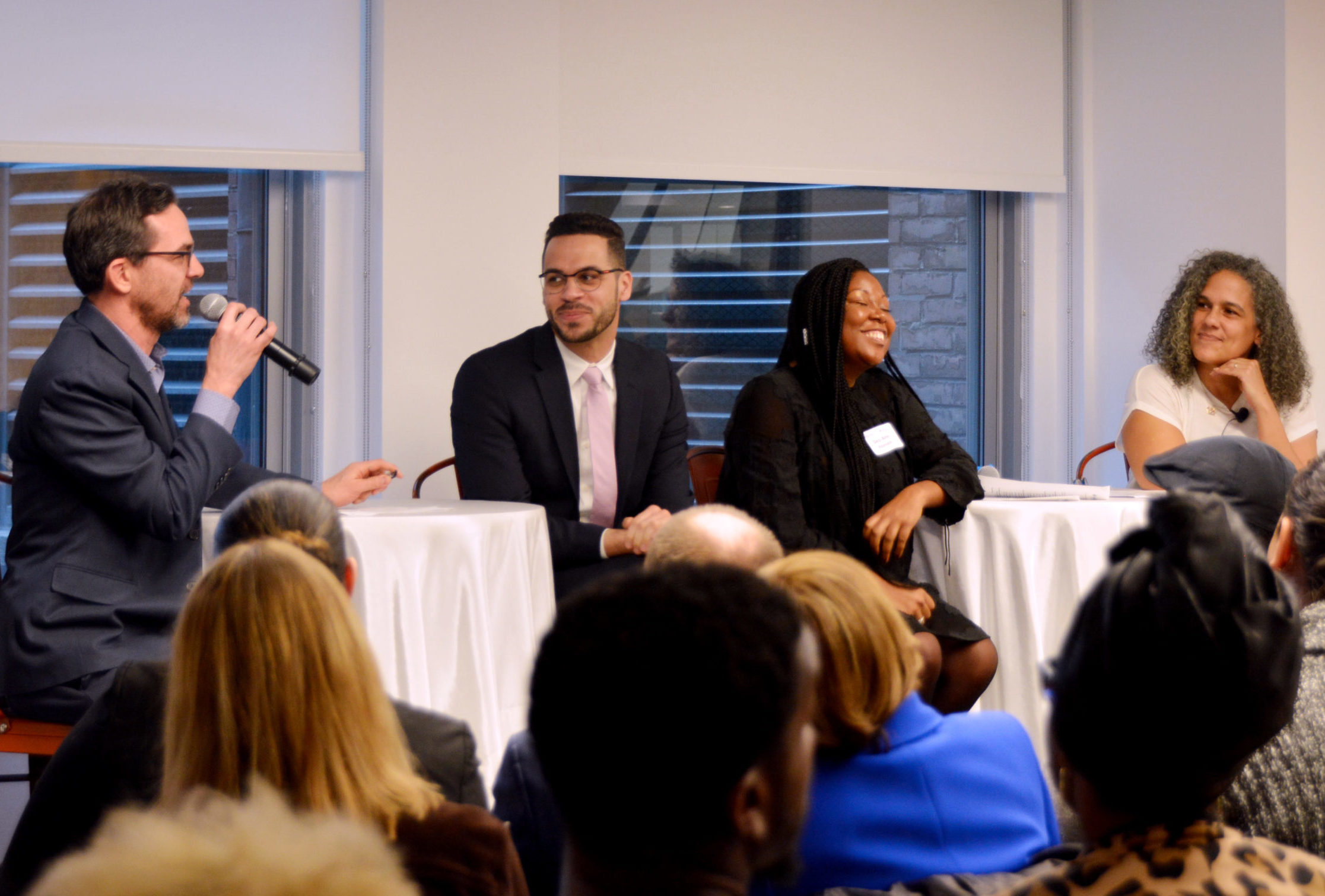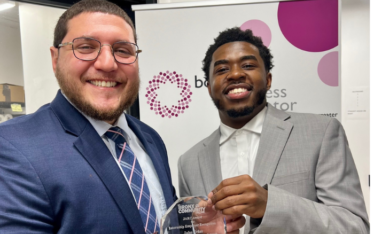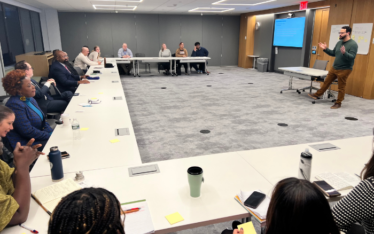JobsFirstNYC and New Visions for Public Schools present
Building Partnerships:
Bringing Together Workforce & School Leaders
March 6, 2018, from 8:30 a.m. to 11:45 a.m. at UJA – Federation
On March 6, 2018, JobsFirstNYC and New Visions for Public Schools hosted Building Partnerships: Bringing Together Workforce & School Leaders, which brought together school leaders—including community-based organization program directors and school principals—and workforce development leaders to build bridges between education and workforce development. We also shared the preliminary design framework and the Request to Participate to solicit ideas from prospective partners for an initiative we are launching.
Jennie Soler-McIntosh, Vice President of Community and Family Engagement for New Visions for Public Schools, gave opening remarks that provided an overview for the day and a summary of the event that JobsFirstNYC and New Visions for Public Schools hosted on January 30, 2018, Stem the the Flow: Reimagining the School-to-Work Experience for Transfer High School Students. At the January event, a range of stakeholders from government, secondary and postsecondary education, workforce development, philanthropy, and other areas began a broader dialogue that identified challenges and opportunities to better connecting Transfer High School students to the economic life of New York City. Highlights from that event include the following:
- Too many over-age, under-credited Transfer High School students are at risk of becoming part of the out-of-school, out-of-work population and face many of the same structural barriers.
- The Transfer High School design, with an embedded Learning to Work partner providing wrap-around supports, is a unique asset to these schools that can be leveraged even more.
- Schools are not currently well equipped to integrate postsecondary readiness or to create structural on-ramps and bridge strategies that will more easily connect students to postsecondary opportunities.
During her opening remarks at the March 6 event, Soler-McIntosh reinforced the three high-level goals of the partnership between JobsFirstNYC and New Visions for Public Schools: (1) universalize career exploration and awareness, (2) embed advanced career development into schools, and (3) create on-ramps and bridges to sector-focused postsecondary opportunities across the 12 schools within the New Visions for Public Schools network.
Following these remarks, participants engaged in a roundtable discussion in which they shared experiences about challenges, lessons learned, and opportunities in formal and informal partnerships with other organizations. Key takeaways from this conversation included the need to have clarity on roles, setting expectations up front, being open to learning and growing one’s own work, and being adaptable to changing dynamics.
Lucinda Mendez, Director of Transfer Schools for New Visions for Public Schools, then provided a detailed overview of the initiative’s preliminary framework. Mendez described the four-phase framework that students will experience during their time in school:
In Phase 1, the Career Awareness and Exploration phase, students will experience an enhanced, integrated curriculum delivered in the context of the target industry, participate in project-based activities with their peers, and engage in career awareness and exploration activities (such as workplace tours and job shadowing) that support both career development and credit recovery goals.
In Phase 2, the Advanced Career Development phase, students will continue to experience an enhanced, integrated curriculum delivered in the context of the target industry, participate in project-based activities with their peers, and engage in more in-depth career exploration and preparation activities (such as internships and work experience) that support both career development and credit recovery goals.
In Phase 3, the Sector-Focused Postsecondary Training phase, which will typically begin while the students are still in high school, students will participate in defined degree and certificate programs, engage in occupational skills training and advanced peer learning experiences, and be supported through continued case management and a peer support network.
In Phase 4, the Launch Career phase, students will continue to participate in peer networking activities and receive support to ensure their retention and advancement.
Following a full-room conversation regarding the presented framework and with the aim of creating a deeper and shared understanding of labor market opportunities for Transfer High School students, Pam Hoberman from the NYC Labor Market Information Service (LMIS) presented on labor market trends for young adults in New York City. This was critical to identifying a range of in-demand sectors with occupations that can serve as points of entry for young adults to launch careers. Although the data and presentation from LMIS will not dictate exactly which sectors or occupations the initiative will focus on, it provided an important tool to inform conversations and potential partnerships.
Lucinda Mendez then facilitated a 50-minute activity entitled “Journey Mapping: Reimagining the School-to-Work Experience for Transfer High School Students,” where participants worked in groups of three—with at least one school representative and one workforce representative in each group—to build a particular student profile and identify a career pathway that the student may choose. The groups mapped out how their student would get from where they are now to the career opportunity they chose. This included building career awareness, undertaking preparation and exploration activities, and engaging in work-based learning and internships. Groups also identified opportunities to build a contextualized curriculum that connected off-campus work experience to the teachings of their core academics. Important highlights include the following:
- Workforce development strategies must be integrated with the core life skills and social-emotional wrap-around supports that students need to be successful.
- Employers should be included in these conversations to help provide opportunities and to inform programs and curricula.
- Student feedback loops should be part of any good program design to ensure that their voice is being heard.
- Program designs must be student centered and should be approached from a strength-based perspective.
- The knowledge and communications gaps between workforce and school are a barrier that requires intentional space to think and build together.
- There is a need for capacity building and professional development all around
Kevin Stump, Vice President of Policy, Communications, and In-School Practice of JobsFirstNYC, then introduced the full framework for the initiative being launched by JobsFirstNYC and New Visions for Public Schools and shared and presented the Request to Participate. The Request to Participate is the vehicle we are using to identify key workforce development partners that we will invite into a learning community and provide a planning grant to.
To close the event, Marjorie Parker, President and CEO of JobsFirstNYC, asked the following groups to identify themselves: principals, Learning to Work leaders, workforce trainers, CUNY and other higher education representatives, Department of Education staff, government leaders, and staff who work with foster youth, youth with disabilities, immigrant youth, youth with criminal justice experience, and other groups. She noted, “You are all here for a reason. You should see yourself in this framework. We invite you to join JobsFirstNYC and New Visions for Public Schools to break down barriers and create clearer pathways for these students to access the economic life of New York City and lead successful lives.”





